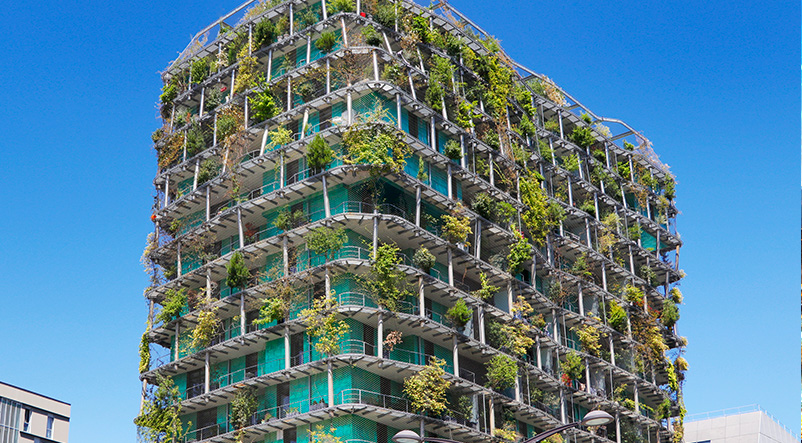
The art of the possible: why real estate will lead the way in the energy transition
The art of the possible: Why real estate will lead the way in the energy transition
Our built environment may be energy inefficient, but the technology already exists to vastly reduce its power consumption and switch the entire sector to renewable sources. Updating assets to be greener not only generates pricing and rental premiums for investors, it also means the real estate industry has a head start on enacting real change.
Originally published on September 12, 2024, by Fidelity International.
Written by Adrian Benedict, Head of Real Estate Solutions, and Nina Flitman, Senior Writer.
Highlights:
- Sustainable buildings offer a premium for investors
- Green buildings reduce tenant operating costs
- EU to upgrade energy-inefficient buildings
The benefits of properties with stronger sustainability profiles are now so demonstrable that both buyers and tenants are willing to pay a premium for them. Advances in building materials and technology mean the real estate sector is taking the lead for investors looking to harness the transition theme.
The scope for change – and investment – is considerable. The built environment is responsible for around 40% of Europe’s energy consumption.1 This is not a figure that can be simply cut to nothing; buildings will always need power to function. But our offices, homes and commercial buildings, many of which date back decades or even centuries, are not always using power in the most effective way, or taking advantage of the latest technology. Around 75% of buildings across the European Union are energy inefficient.2
Realizing their potential can be relatively straightforward, and it does not mean knocking down our cities to start again. After all, demolition and construction are the most carbon-intensive stages of a building’s life cycle. Renovating an existing asset creates 60% less embodied carbon compared to building something new.3 Add the latest technological innovations, and the amount of carbon needed to operate the building can also be reduced to zero.
What does that look like? There are the basics: installing improved insulation, adding more efficient LED lighting, heating, ventilation, and air conditioning systems to reduce the power a building needs. But a building can also generate its own green power. Rooftop solar panels or wind turbines, or replacing traditional gas and oil-powered boilers with air-sourced heat pumps, can end the reliance on carbon-based fuels.
Then there are the new technologies in development that offer exciting glimpses into the future. The creation of fully transparent photovoltaic panels could soon mean that every window in an office or home can generate solar electricity. Innovations in sustainable materials and their manufacture, such as carbon-negative cement, green steel produced without the use of fossil fuels, or even mycelium bricks made from organic waste and fungi fibres, could all play a part in reducing carbon in construction. Given that concrete production is responsible for up to 8% of global carbon dioxide emissions, any improvements here would have a dramatic impact.4
Ahead of the curve
The European Union estimates that renovating all of its inefficient buildings to be more sustainable could reduce the region’s total energy consumption by 5% to 6%.5 It’s an ambitious figure, but individual projects demonstrate the extent to which an asset’s energy footprint can be cut if remodelled with power efficiency in mind. Take for example a central London office block that’s currently undergoing such a remodelling. This is not an old, crumbling brown building: this is an asset originally built in the early 21st century, but a mere twenty years on we’re in a position to improve radically its energy efficiency. Upgrading its facilities with many of the technologies listed above will reduce the primary energy demand of the building by more than 75%. On completion, the building will be capable of operating at net-zero carbon, with no reliance on fossil fuels at all.
All of this technology puts the real estate sector ahead of the curve for the energy transition. Although not every building has a heat pump installed or a network of solar panels lining its roof yet, that is only because of a lack of capital or management foresight. That capital is on the way though. Because sustainable buildings are still relatively scarce in Europe – less than 20% of offices across big European cities have a green certificate6 – there is an attractive green premium on offer for those buying into the sector.7 One report showed that total returns for efficient buildings in the 12 months to the second quarter of 2023 were 1.2 percentage points higher than for inefficient buildings, with the differential growing to 3.2 percentage points between inefficient and efficient offices.8
Tenants are also willing to pay more to rent sustainable buildings: almost three-quarters of corporate real estate decision-makers say they are likely to pay a premium to occupy an office with green credentials, with over half planning to do so by 2025.9 Similarly, around two-thirds of occupiers renting logistics facilities such as warehouses are planning to be net zero across their property footprint before or during 2030.10 While a green building may cost companies more to rent, their energy efficiency can mean that operating bills are lower, reducing their overall spend on occupying the real estate.
Taking the weight
The process of investment and renovation must accelerate if climate goals are to be met. Some 80% of existing commercial real estate in the European Union needs updating to become more efficient,11 although only 1% of buildings in the region undergoes energy-efficient retrofits each year.12
Increasing the pace of renovations even by a small amount would significantly cut the energy used by real estate. Given that other industries will find it harder to reduce their reliance on fossil fuels, accelerating improvements in this sector could help with reaching net zero targets even as other sectors fall behind. In addition, if our buildings can cut the amount of energy they use, the aggregate demand for renewable electricity could come down. This would offset the growth in demand from other industries that are unable to cut their energy usage as quickly – an increasing concern given supply constraints – while also helping to alleviate the pricing pressure for those more difficult-to-abate sectors.
The targets laid out by the Paris Climate Agreement are moving out of reach, and the time frame in which we have to take action is narrowing. Those sectors that have the capacity to implement change, including real estate, should do so in earnest, and welcome the wave of investment that follows.
1 In focus: Energy efficiency in buildings, European Commission.
2 In focus: Energy efficiency in buildings, European Commission.
3 Energy efficiency of the building stock in the EU, RICS.
4 Making concrete change, Chatham House Report.
5 In focus: Energy efficiency in buildings, European Commission.
6 The Value of Green Building Features, CBRE Research.
7 Buildings that go green: making an impact while still making alpha, Fidelity International.
8 Sustainability Index 2023, CBRE.
9 The Future of Work Survey, JLL.
10 European Logistics Occupier Survey 2024, CBRE.
11 According to data from the Royal Institute of Chartered Surveyors.
12 According to data from the International Energy Agency.
Issued by Fidelity Investments Canada ULC (“FIC”). Unless otherwise stated, all views expressed are those of Fidelity International, which acts as a subadvisor in respect of certain FIC institutional investment products or mandates.
For institutional use only.
This document is for investment professionals only and should not be relied on by private investors.
This document is provided for information purposes only and is intended only for the person or entity to which it is sent. It must not be reproduced or circulated to any other party without the prior permission of Fidelity.
This document does not constitute a distribution, an offer or solicitation to engage the investment management services of Fidelity, or an offer to buy or sell or the solicitation of any offer to buy or sell any securities in any jurisdiction or country where such distribution or offer is not authorized or would be contrary to local laws or regulations. Fidelity makes no representations that the contents are appropriate for use in all locations or that the transactions or services discussed are available or appropriate for sale or use in all jurisdictions or countries or by all investors or counterparties.
This communication is not directed at and must not be acted on by persons inside the U.S. and is otherwise only directed at persons residing in jurisdictions where the relevant funds are authorized for distribution or where no such authorization is required. Fidelity is not authorized to manage or distribute investment funds or products in, or to provide investment management or advisory services to persons resident in, mainland China. All persons and entities accessing the information do so on their own initiative and are responsible for compliance with applicable local laws and regulations and should consult their professional advisors.
Reference in this document to specific securities should not be interpreted as a recommendation to buy or sell these securities but is included for the purposes of illustration only. Investors should also note that the views expressed may no longer be current and may have already been acted upon by Fidelity. The research and analysis used in this documentation is gathered by Fidelity for its use as an investment manager and may have already been acted upon for its own purposes. This material was created by Fidelity International.
This article has been provided by Fidelity Investments Canada ULC (Fidelity) and is for information purposes only. It comprises, among other things, examples of sustainable investing activities across Fidelity and FIL Limited (Fidelity International) only, current as at September 9, 2024. The article may refer to ESG considerations that Fidelity and Fidelity International may take into account as part of their research or investment process, and is not necessarily reflective of the approach of any other Fidelity Investments company or subadvisor, such as Fidelity Management & Research Company LLC, FIAM LLC, Geode Capital Management LLC, and State Street Global Advisors Ltd., to ESG research, stewardship and sustainable investing, either specifically or generally.
Past performance is not a reliable indicator of future results.
This document may contain materials from third parties which are supplied by companies that are not affiliated with any Fidelity entity (third-party content). Fidelity has not been involved in the preparation, adoption or editing of such third-party materials and does not explicitly or implicitly endorse or approve such content.
Fidelity International refers to the group of companies which form the global investment management organization that provides products and services in designated jurisdictions outside of North America. Fidelity, Fidelity International, the Fidelity International logo and F symbol are trademarks of FIL Limited. Fidelity only offers information on products and services and does not provide investment advice based on individual circumstances.
©2024 Fidelity Investments Canada ULC. All rights reserved.

